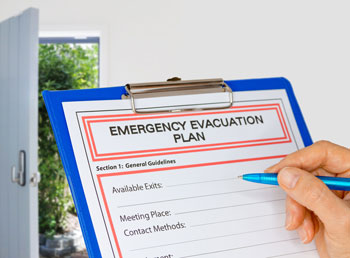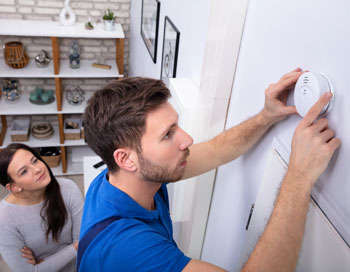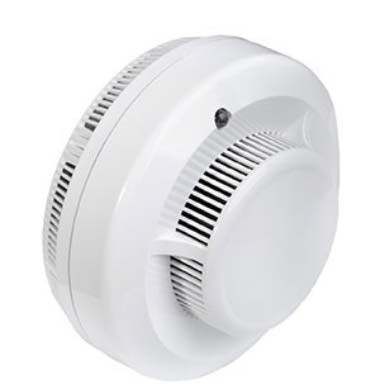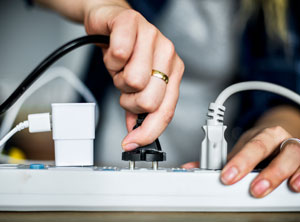Awareness of Residential Fire Safety
More than one-quarter (27%) of reported fires in 2014-2018 occurred in homes. Even worse, more than three-quarters (77%) of civilian fire deaths and almost three-quarters (73%) of all reported injuries were caused by home fires.
During this five-year period, US fire departments responded to an estimated average of 353,100 home structure fires per year. These fires caused an annual average of 2,620 civilian deaths; 11,030 civilian fire injuries; and $7.2 billion in direct property damage.
Most home fires and fire casualties result from five causes: cooking, heating, electrical distribution and lighting equipment, intentional fire setting, and smoking materials. Over the five-year period of 2014–2018 as a whole, cooking was the leading cause of home fires and home fire injuries, while smoking was the leading cause of home fire deaths.
Escape Plans Could Mean the Difference Between Life and Death
Plan escape routes and practice them. This could mean the difference between life and death during a fire emergency.
If you have a plan, you won’t waste precious moments trying several unsuccessful escape routes. Escaping by walking down the hallway and out the front door may be impossible, so plans can save your life and the lives of your family may be saved.

The basics for a good home escape plan as compiled by experts at the National Fire Protection Association (NFPA) are:
- Each family member must know where to go and what to do in case of fire. Be acquainted with EDITH (Exit Drills in the Home).
- The basis for a fire escape plan is simple: GET OUT! Every second counts!
- Plan at least two routes to the outside from every room in the house, especially bedrooms.
- Arrange a home fire alert signal loud enough to make sure everyone is awake.
- Have family members sleep with bedroom doors closed to hold back smoke, heat and flame. This may provide extra time to escape by alternate routes.
- If a window is the only alternate escape route, be sure it opens easily. Have an escape rope or ladder from upper floors.
- Designate a place well away from the house where all family members will meet. Meeting place should be near the front of your home, so firefighters know you are out. Be sure everyone understands that the house must not be reentered for any purpose.
- Always notify the fire department using a cell phone or from a street alarm, not from inside your own burning house.
- Know to crawl low to the floor when escaping to avoid toxic smoke. Get down on your hands and knees and crawl if there is smoke.
- Stop, drop and roll if your clothes catch on fire to smother the flames.
- Practice your fire escape plan.
Learn more about how to make a fire escape plan.
What are common fire hazards in the home?
Equipment breakdown, carelessness and deficiency of knowledge about fire safety contribute to most accidental home fires. Most mechanical equipment, whether an electrical appliance, a gas-fired furnace or a wood heater, generally will not cause a fire when it breaks down if it is correctly installed, properly maintained and properly used. This means the manual’s directions regarding installation, care and use of the equipment must be followed.

What are the top causes of residential fires?
According to the NFPA, most home fires and fire casualties result from five causes:
- cooking
- heating
- electrical distribution and lighting equipment
- intentional fire setting
- smoking materials
The NFPA stated that, during the period 2010 to 2014, cooking was the leading cause of residential fires as well as residential injuries and ties with heating as the second leading cause of home fire deaths as shown in Table 1.
Table 1. Causes and Effects of Residential Fires Between 2010 and 2014 (Adapted from the National Fire Protection Association).
| Cause | Fires | Deaths | Injuries |
|---|---|---|---|
| Cooking equipment | 46% | 19% | 44% |
| Heating equipment | 16% | 19% | 12% |
| Electrical and lighting equipment | 9% | 16% | 9% |
| Intention | 8% | 14% | 7% |
| Smoking materials | 5% | 22% | 10% |
| Other | 16% | 10% | 18% |
Smoking was the leading cause of civilian fire deaths in the United States. Heating equipment was the second most common cause of home fires. Many home fires start where they are likely to block the usual hallway or stairway exit. Normal exit paths can quickly become death traps when the bedroom door is opened.
When and where do most home fires occur?
Locations where residential fires start have been traced for some of the fires:
- kitchen, 24%
- bedrooms, 13%
- living room, 8%
- chimney, 7%
- laundry, 5%.
Unfortunately, during three days – New Year’s Day, Christmas Day and New Year’s Eve – most home candle fires occur.
Some reports indicated that most home fires start between midnight and 6 a.m., when residents are asleep and least prepared to survive a fire.

Fire experts estimate that most home fires could be prevented if families were aware of common fire hazards. They also estimate that up to 60% of all lives (civilians and firefighters) could be saved if homes were equipped with working smoke detectors (see Figure 1) and if families had escape plans.
Read more about the top causes of fire
People at Risk During Home Fires
When assessing fire risks, it is important to identify vulnerable groups or individuals. This includes children, the elderly or those with a disability. Older adults aged 65 or older are twice as likely to be killed or injured by fires compared to the population at large.
The death rate from fire in rural communities is roughly twice the rate of the rest of the country. People with disabilities are at higher risk in home fires and should be included in safety planning.
Read more about protecting at risk people during home fires
Properties at Risk From Home Fires
The risk of fire is not limited to homes occupied by a single family. Apartments, campuses and dorms, high-rise buildings, hotels and motels, nightclubs and other assembly occupancies, nursing homes, schools and vehicles should be included when assessing risk from fire.
Get safety tips and learn how to assess fire risks of multi-family living, high-rise buildings, and entertainment spaces
Fire Safety Equipment
Fire safety equipment has a big impact in reducing the loss of life and property from fire. If there is a fire in your home, smoke spreads fast and you need smoke alarms to give you time to get out. Fire sprinkler systems react quickly. They can dramatically reduce the heat, flames and smoke produced in a fire.
The correct fire extinguisher in a handy location can reduce fire losses tremendously. The most practical for household use is a multipurpose dry chemical extinguisher labeled Class A-B-C. This means the extinguisher can be used on localized fires, smothering such material as wood, paper, cloth, flammable liquids, grease and electricity.
Select a fire extinguisher that has the label of a major testing laboratory. Follow regular maintenance and inspection procedures recommended by the manufacturer. Take fire extinguishers to a competent fire department or fire extinguisher service establishment to be recharged after use on a fire, even if only partially used in putting out a small fire.
Early Warning Devices - Smoke Detectors
Early warning devices have saved many lives from fire. Fire warning devices can be grouped into two general categories – smoke detectors and heat detectors. As the names imply, smoke detectors identify smoke and warn occupants, while heat detectors react to the presence of heat. Studies show that most fires start by smoldering and that the majority of fire fatalities result from inhalation of smoke and toxic gases. Therefore, smoke detectors are vital as an early warning detection device. There are two types of smoke detectors:
- Ion chamber detectors – This smoke detector uses a negligible radiation source to produce electrically
charged molecules (ions) in the air. This sets up an electric current within the detector
chamber. When smoke enters the chamber, it reduces the flow of current and sets off
the alarm.
- Photoelectric detectors – This smoke detector uses a photoelectric beam like an “electric eye.” When smoke blocks light to the eye, current flow is reduced and thus triggers the alarm.
In general, photoelectric smoke detectors respond to small quantities of visible smoke particles. The ionization-type responds to small quantities of smoke-containing particles that are invisible. Both are effective for home fires. Photoelectric may be preferable for use in cooking areas. Smoke detectors are self-contained units that can either run on batteries or be plugged into existing electrical systems.
Where residential fires have occurred, about two-thirds of the smoke alarms were missing or not working.
What are some tips for smoke detectors?
- Install and maintain a smoke detector according to the recommendations of the manufacturer.
- Install smoke detectors in every sleeping room, outside each separate sleeping area
and on every level of the home.
- Install extra smoke detectors in large homes.
- Make sure smoke detectors are interconnected. When one sounds, they all sound.
- Test smoke detectors at least once a month by pressing the test button to make sure
the detector is working.
- Replace all smoke detectors in your home every 10 years.
- Change the smoke detector batteries as needed.
- Go outside as soon as possible when a smoke detector sounds.
Get more tips for Fire and Life Safety Equipment
Electrical and Appliance Safety
Home fire prevention from electrical sources starts with having your home wired in accordance with the electrical code for your locality. If you live in an area where there is no code, insist that the National Electrical Code should be followed and that wiring is installed by a competent professional.

- Do not alter your home wiring unless you are qualified.
- Never bypass a fuse or circuit breaker, and do not increase the size of one that is in place.
- Every circuit must have correctly sized protection.
- Permanently wired appliances – ranges, disposals and dishwashers – should be installed following the manufacturer’s instructions.
- Make sure large and small appliances are plugged directly into wall outlets.
- Pay particular attention to clearances, fuse and wire sizes for that circuit and electrical grounding.
- Portable electric appliances should be frequently inspected for abuse. Carefully inspect the cord and plug for frayed or worn insulation.
- Do not use extension cords for permanent outlets.
- Never nail or staple extension cords around doors or windows or run them under carpeting or throw rugs.
- Clean the clothes dryer lint filter and venting system.
- Never put over-sized light bulbs in light fixtures. It not only shortens bulb life, but it also overheats the fixture, may deteriorate insulation on internal wiring connections and may cause a fire.
What are some safety tips for heating the home?
Heating equipment is the cause of 19% of home fire deaths, as shown in Table 1. Half of home heating equipment fires are reported during the months of December, January and February. Some simple steps can prevent most heating-related fires.
- Keep anything that can burn at least 3 feet away from heating equipment – furnaces, fireplaces, wood stoves or portable space heaters.
- Have a 3-foot “kid-free zone” around open fires and space heaters.
- Never use your oven to heat your home.
- Have a qualified professional install water heaters, stationary space heating equipment or central heating equipment according to the local codes and manufacturer’s instructions.
- Have heating equipment and chimneys cleaned and inspected yearly by a qualified professional.
- Shut off/unplug portable heaters when adults are not in the vicinity.
- Never use extension cords with space heaters.
- Make sure heaters are approved by a national testing laboratory and have a tip-over shut-off function.
- Use the right kind of fuel, as specified by the manufacturer, for fuel-burning space heaters.
- Make sure the fireplace has a sturdy screen to stop sparks from flying into the room.
- Cool ashes before putting them in a metal container. Place and keep the container away from your home.
- Pay attention to gas furnaces, particularly heat exchangers and vents for flue gases.
- Replace burned-out heat exchangers or rusted-out burners because they are hazardous.
- Maintain proper cleaning around heating equipment because dust accumulation can be hazardous.
- Use a safe flue system and adequate combustion air for gas-fired equipment to minimize the possibility of carbon monoxide poisoning.
- Do not place portable heaters where they can be bumped over.
Wood Stove Safety Tips
Fires caused by wood stoves can often be traced back to an inadequate or unserviceable flue. However, a flue fire can ignite a house even if the flue has been installed properly. Repetitive flue fires weaken and damage flues making them unsafe to use.
- Clean and inspect the chimney and furnace yearly.
- Place fireplace and barbecue ashes outdoors in a covered metal container at least 3 feet from anything that can catch fire.
- Set the wood stove on a safe hearth or stove mat with proper clearance from combustible materials on all sides and the top.
- Avoid using homemade or burned-out stoves.
- Be sure the hearth or stove mat is constructed so that sparks cannot burn through it. It must also be large enough to prevent sparks from popping out on the floor in front of the loading door or air vents.
- Make sure clearances from combustible surfaces range from 18 to 36 inches on all sides depending on stove construction.
- Keep furniture and other items that can catch fire at least 3 feet from fireplaces and from wall, baseboard and space heaters.
- Be sure to allow the 36-inch distance from walls if you are not positive the stove is certified for less clearance. Clearance can be reduced by 12 inches from walls that have been protected by a noncombustible heat shield spaced at least 1 inch from the wall.
- Make sure flues are listed by Underwriters Laboratories (UL or similar independent testing laboratory) and should be the Class A, All Fuel type.
- Use a flue that is made from tile-lined masonry, preferably with double brick around the tile. The connector pipe from the stove to the flue can be a single-wall stove pipe, not to exceed 10 feet.
Flammable Liquids Safety
Gasoline is often the most common flammable liquid around the home. It is also one of the most dangerous. Homeowners may have a gallon or two of gasoline stored for use in a lawn mower, chainsaw, weed trimmer, ATV, etc.
Gasoline should be stored in approved safety cans. It should never be stored in the trunk of a car, inside the home or in any room where an open flame (pilot light) is present.
A typical hazard is a garage storage room housing a gas clothes dryer or water heater and the gasoline can. Never store flammable liquids in rooms where gas-fired appliances are located. Remember that a closed area inside the home that includes a gas water heater should not be used for gasoline storage.
Never use or store gasoline around ignition sources!
House Ventilating Fans - A Possible Fire Hazard
Energy costs have encouraged many homeowners to install attic fans. These fans are usually mounted in the ceiling and pull air into the home and discharge it through the attic.
They may create a negative pressure inside the house and can pull air backwards through gas flue vents creating a fire hazard, if backdraft dampers or draft hoods are not properly attached to the gas flue. If the home has gas appliances and a whole-house ventilating fan is installed, check appliances to be sure cover plates and draft hoods are intact and that all appliances have been installed with proper clearances from combustibles.
More Ways to Avoid Fire Hazards in the Home
Good personal habits and housekeeping practices can reduce fire hazards in your home. Take the time to check your home for fire hazards.
- Remove accumulations of papers, Christmas boxes, rags and other dry items that can become a fire hazards. They often are kept in the worst possible places – under stairs or in a storage room where a hot water heater is located.
- Keep cooking area clear of items that can catch fire.
- Keep kitchen stove hood clean and ensure it is vented to the outside.
- Never leave pots unattended on the stove.
- Candles are in sturdy, fire-proof containers that won’t be tipped over.
- All candles are extinguished before going to bed or leaving the room.
- Never leave children and pets unattended with candles.
Smoking is the biggest personal cause of fire. Use these safety tips:
- Use large ashtrays.
- Empty ashtrays into a container that will not burn.
- Never smoke in bed or while dozing in a chair or on a couch.
- Keep matches and lighters away from children and out of sight.
- Only buy fire-safe cigarettes and smoke outside.
Protect Your Family From Fire - Recap
Keep your family safe from fire. Be aware of the hazards in your home. Also, be sure to have an escape plan. Pull together everyone in your household and make a plan. Walk through your home and inspect all possible exits and escape routes.
- Take time to locate fire hazards around your home. Correct these hazards; prevent a fire if possible.
- Install more smoke detectors to alert you in case of fire. Replace batteries immediately when they begin “chirping.” A few extra minutes or seconds provided by an alarm may be extremely important to allow a safe escape.
- Learn the steps to create and practice a home fire escape plan. Discuss and practice the fire escape plan with your family. If the family has discussed and practiced the fire escape plan, chances are that training, rather than panic, will determine personal reaction.
- Have fire extinguishers in proper locations in the home for use on localized fires. Consider locations in cooking areas and laundry room and near chimneys.
- Be aware that most “fire-related injuries” are burns.
- Clean the home clothes dryer and washer to prevent fires.
- Emergency preparedness disasters can occur suddenly and without warning.
- Always handle gasoline used in the home or propane-powered equipment cautiously.
- Many fire departments are experiencing serious fires, injuries and deaths as the result of compulsive hoarding behavior.
- The fuel, device and open flame from combustible products can be dangerous.
- The most common dangers with portable generators are carbon monoxide (CO) poisoning, electrical shock and fire hazards.
- A closed door may slow the spread of smoke, heat and fire.